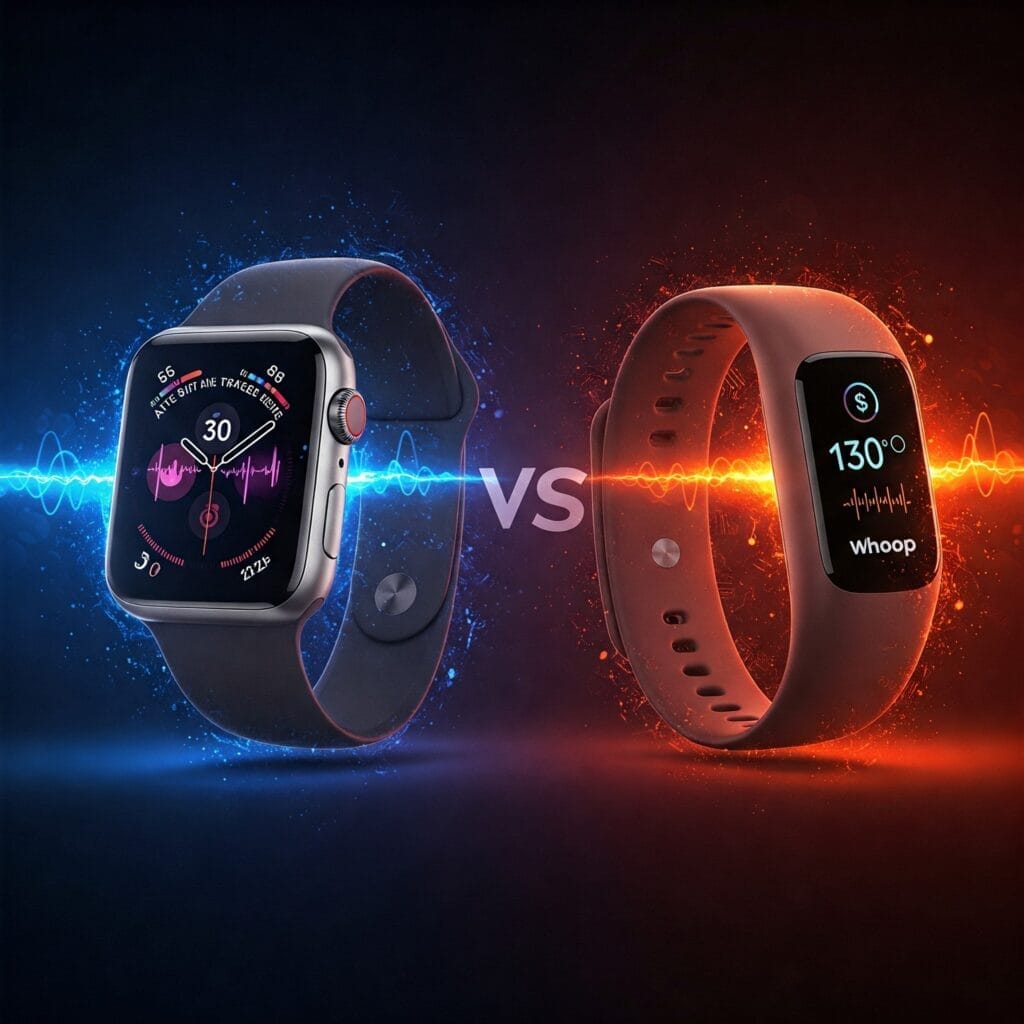Wearable Tech Showdown: Apple Watch vs. Whoop for Fitness Tracking
Experience the ultimate wearable tech showdown: Apple Watch vs. Whoop for Fitness Tracking. Discover in-depth comparisons, real-user insights, and actionable tips—elevate your fitness journey today!

Table of Contents
- Introduction: A New Era of Wearable Fitness
1.1 Welcome to the Wearable Revolution
1.2 Setting the Stage for a Showdown
1.3 Why Fitness Tracking Matters
1.4 Overview of Top Devices
1.5 Defining the Key Contenders - The Evolution of Wearable Fitness Technology
2.1 From Pedometers to Smart Devices
2.2 Milestones in Wearable Tech
2.3 Shifting Trends in Health Monitoring
2.4 Impact on Modern Lifestyles
2.5 How Wearables Transformed Fitness Tracking - Detailed Analysis of the Apple Watch
3.1 Sleek Design and Build Quality
3.2 Comprehensive Health Monitoring
3.3 Advanced Features and Ecosystem Integration
3.4 Software Innovations and Updates
3.5 Real-World User Experience - Detailed Analysis of Whoop for Fitness Tracking
4.1 Unique Technology Behind Whoop
4.2 In-Depth Health Metrics and Analytics
4.3 Comfort and Wearability
4.4 User Interface and Data Insights
4.5 Testimonials and Community Feedback - Comparative Review: Apple Watch vs. Whoop
5.1 Feature-by-Feature Breakdown
5.2 Performance and Accuracy Metrics
5.3 Price, Subscriptions, and Value Comparison
5.4 Pros and Cons at a Glance
5.5 Comprehensive Comparison Table - Real-World Case Study: Transforming Fitness with Wearable Tech
6.1 Introducing the Case Study
6.2 The Challenge and Initial Struggles
6.3 The Transformation Journey
6.4 Quantitative Results and User Insights
6.5 Lessons Learned and Future Outlook - Custom Statistics and Data Visualizations
7.1 Statistic: Apple Watch User Engagement Trends
7.2 Statistic: Whoop’s Impact on Performance Improvement
7.3 Visualization: Year-over-Year Growth Comparison
7.4 Analysis of Adoption Rates
7.5 Future Projections in Wearable Technology - Actionable Tips for Maximizing Your Wearable Device
8.1 Tip 1: Optimize Your Device Settings
8.2 Tip 2: Sync with Health and Fitness Apps
8.3 Tip 3: Regular Data Reviews for Adjustments
8.4 Tip 4: Participate in Community Challenges
8.5 Tip 5: Maintain Your Device for Longevity - Frequently Asked Questions about Wearable Fitness Trackers
9.1 What distinguishes the Apple Watch from Whoop?
9.2 Which device offers better health monitoring?
9.3 How accurate are these fitness trackers?
9.4 Are these devices worth the investment?
9.5 How do subscription models affect overall value?
9.6 What additional features should users consider?
9.7 Can these devices boost overall fitness performance?
9.8 How do the devices compare in data privacy? - Key Takeaways and Conclusion
10.1 Summary of Major Insights
10.2 Future Outlook in Wearable Fitness Tech
10.3 Final Verdict: Which Device Wins?
10.4 Recommendations for Different Lifestyles
10.5 Call to Action: Elevate Your Fitness Journey
1. Introduction: A New Era of Wearable Fitness
In today’s fast-paced world, the debate over Apple Watch vs. Whoop for Fitness Tracking is heating up, and it’s clear that wearable technology is no longer just a novelty. With health and fitness at the forefront of many people’s minds, smart devices have evolved to provide not only basic tracking but also in-depth insights into every aspect of our well-being. Furthermore, as you embark on this wearable tech showdown, you’ll quickly notice how these devices are transforming personal health management.
In this blog, we will explore the wearable tech landscape with a focus on two of the most talked-about devices in the market. First, we dive into the origins and evolution of wearable fitness technology, and then we move on to detailed analyses of both the Apple Watch and Whoop. Moreover, we will examine their features, performance metrics, and user experiences. Finally, actionable tips, real-world case studies, and comparative data will help you decide which device aligns best with your lifestyle. By the end of this post, you will have a clear understanding of what makes each device unique and how they measure up in this ultimate fitness tracking battle.
1.1 Welcome to the Wearable Revolution
Wearable technology has dramatically changed the way we approach fitness and health monitoring. Today’s devices do more than count steps—they monitor heart rates, track sleep quality, and even assess stress levels. Consequently, the integration of these features has sparked a revolution in personal health management.
1.2 Setting the Stage for a Showdown
With numerous options on the market, choosing the right fitness tracker can be daunting. However, the contest between the Apple Watch and Whoop has emerged as one of the most compelling comparisons in the industry. In this post, we set the stage for an in-depth evaluation by outlining their core functionalities and benefits.
1.3 Why Fitness Tracking Matters
Understanding the importance of fitness tracking is crucial. These devices not only provide real-time data about your body but also motivate you to improve your performance. For instance, regularly monitoring your heart rate can help you maintain optimum exercise intensity and avoid overexertion.
1.4 Overview of Top Devices
Both the Apple Watch and Whoop have carved out significant niches in the market. While the Apple Watch offers a comprehensive ecosystem with various apps and features, Whoop focuses specifically on in-depth fitness analytics. As we progress, we will dissect these devices to uncover what sets them apart.
1.5 Defining the Key Contenders
Ultimately, the choice comes down to your personal needs. Are you looking for a multifunctional smartwatch that also excels at fitness tracking, or do you prefer a device that delivers specialized insights into your workout performance? The answers to these questions are fundamental to understanding the nuances of this wearable tech showdown.
2. The Evolution of Wearable Fitness Technology
Wearable fitness technology has come a long way since the early days of simple pedometers and basic heart rate monitors. The journey from rudimentary devices to advanced smart wearables is a fascinating one that reflects rapid technological advancements and changing consumer demands.
2.1 From Pedometers to Smart Devices
Initially, fitness tracking was limited to counting steps and monitoring basic activity levels. Early devices provided minimal data and were primarily used by athletes and enthusiasts. However, as technology advanced, these devices began incorporating features such as heart rate monitoring, GPS tracking, and even sleep analysis. Consequently, the landscape of wearable technology expanded to cater to a broader audience.
2.2 Milestones in Wearable Tech
Over the years, several key innovations have defined the evolution of wearable devices. First, the integration of sensors capable of tracking multiple health metrics revolutionized the industry. Then, with the advent of smartwatches like the Apple Watch, the line between fitness trackers and personal smart devices blurred. As a result, consumers now have access to a device that not only tracks their fitness but also connects them to a wider ecosystem of digital services.
2.3 Shifting Trends in Health Monitoring
Nowadays, health monitoring has evolved to include advanced analytics and machine learning. For example, both the Apple Watch and Whoop harness complex algorithms to analyze your performance data, providing insights that go far beyond simple metrics. Moreover, these advancements have led to more personalized and actionable fitness guidance, empowering users to make informed decisions about their health.
2.4 Impact on Modern Lifestyles
Today, wearable technology plays an integral role in daily life. Many individuals rely on these devices to manage their workouts, monitor health indicators, and even stay connected with their digital communities. Additionally, the convenience of having a personal health assistant on your wrist has made these devices indispensable for many fitness enthusiasts.
2.5 How Wearables Transformed Fitness Tracking
Overall, the transformation of fitness tracking through wearable technology is evident in the data. Transitioning from basic trackers to sophisticated wearables has enabled users to access a wealth of information about their bodies. For instance, real-time monitoring of biometrics not only aids in improving performance but also in preventing injuries. As technology continues to advance, we can expect further enhancements that will push the boundaries of what these devices can do.
3. Detailed Analysis of the Apple Watch
The Apple Watch has long been a frontrunner in the wearable tech market. Its sleek design, robust functionality, and seamless integration with the Apple ecosystem have contributed to its immense popularity. In this section, we take a deep dive into the features that make the Apple Watch a standout device for fitness tracking.
3.1 Sleek Design and Build Quality
The Apple Watch is renowned for its premium build quality and modern aesthetic. Its design not only appeals to fashion-conscious users but also ensures durability and comfort during workouts. Additionally, the device’s lightweight construction and customizable bands make it suitable for all-day wear. Furthermore, the intuitive interface ensures that users can easily navigate through various features, thereby enhancing the overall user experience.
3.2 Comprehensive Health Monitoring
One of the Apple Watch’s most notable strengths is its comprehensive suite of health monitoring features. For instance, it tracks your heart rate, measures blood oxygen levels, and even performs electrocardiogram (ECG) readings. Moreover, the device automatically detects irregular heart rhythms, alerting users to potential health issues. Consequently, these features provide peace of mind by ensuring that users have real-time insights into their cardiovascular health.
3.3 Advanced Features and Ecosystem Integration
In addition to health tracking, the Apple Watch is packed with advanced functionalities that integrate seamlessly with the broader Apple ecosystem. For example, users can receive notifications, make calls, and access a wide range of third-party apps directly from their wrist. Furthermore, the integration with Apple Health and other wellness apps provides a holistic view of one’s fitness journey, making it easier to set and track goals over time.
3.4 Software Innovations and Updates
Apple’s commitment to continuous improvement is evident in the frequent software updates that enhance the device’s performance and introduce new features. As a result, the Apple Watch remains at the cutting edge of wearable technology. Moreover, these updates often include enhancements to the fitness tracking algorithms, ensuring that users always have access to the latest insights and personalized recommendations.
3.5 Real-World User Experience
Many users praise the Apple Watch for its ease of use and comprehensive health monitoring capabilities. For instance, real-world testimonials highlight how the device’s intuitive design and robust data tracking have helped users better manage their fitness routines. Furthermore, the watch’s ability to seamlessly integrate into daily life—whether through tracking workouts, monitoring sleep, or providing motivational insights—has cemented its status as a leading fitness tracker.
4. Detailed Analysis of Whoop for Fitness Tracking
Whoop has carved out a niche for itself by focusing on specialized fitness tracking and recovery metrics. Unlike multifunctional smartwatches, Whoop is dedicated to providing detailed insights into athletic performance and recovery, making it a favorite among serious athletes and fitness enthusiasts.
4.1 Unique Technology Behind Whoop
Whoop distinguishes itself through its focus on high-frequency data collection and in-depth analysis. The device is designed to continuously monitor physiological signals, such as heart rate variability (HRV) and sleep patterns, with remarkable precision. Moreover, Whoop’s algorithms analyze this data to provide users with personalized recommendations that help optimize performance and recovery.
4.2 In-Depth Health Metrics and Analytics
One of the standout features of Whoop is its ability to provide granular insights into your body’s performance. For example, the device measures strain, recovery, and sleep quality in a way that goes beyond simple step counts. Consequently, users receive actionable data that informs them how to adjust their training intensity. Additionally, the platform presents this information through an intuitive interface that makes complex data easily digestible.
4.3 Comfort and Wearability
Whoop is designed with an emphasis on comfort, ensuring that users can wear it continuously without discomfort. Its lightweight band and unobtrusive design mean that the device is ideal for 24/7 monitoring. Furthermore, the adjustable strap and sleek aesthetics add to its appeal, particularly for users who prioritize both function and style in their wearable tech.
4.4 User Interface and Data Insights
The Whoop app is structured to provide users with a clear overview of their performance metrics. It presents data in easily understandable visual formats, such as graphs and trend lines, which enable users to track progress over time. Moreover, the app’s dashboard is customizable, allowing users to focus on the metrics that matter most to them. As a result, the insights derived from Whoop’s data can be directly applied to improve training routines.
4.5 Testimonials and Community Feedback
User testimonials consistently praise Whoop for its detailed and accurate insights. Many athletes have reported that the device has been instrumental in helping them fine-tune their training regimens. Additionally, the community aspect of Whoop—where users share experiences and tips—further enhances its appeal. Consequently, the device has built a loyal following among users who are serious about optimizing their performance.
5. Comparative Review: Apple Watch vs. Whoop
In this section, we undertake a head-to-head comparison of the Apple Watch and Whoop. By examining key features, performance metrics, and user feedback, we provide an in-depth analysis that helps you determine which device might be best for your fitness tracking needs.
5.1 Feature-by-Feature Breakdown
When comparing the Apple Watch and Whoop, it is essential to look at their core functionalities. The Apple Watch offers a broad array of features that extend beyond fitness tracking, while Whoop is laser-focused on athletic performance and recovery. Additionally, each device has its own strengths: the Apple Watch boasts a vibrant display, a multitude of apps, and seamless integration with other Apple products, whereas Whoop excels in providing detailed physiological data and recovery metrics.
5.2 Performance and Accuracy Metrics
Both devices are highly regarded for their accuracy, yet they serve slightly different purposes. For example, the Apple Watch’s sensors are designed for everyday health monitoring and offer a balance between convenience and precision. On the other hand, Whoop’s high-frequency data collection is particularly advantageous for users who require deep insights into their training strain and recovery. Consequently, the choice often depends on whether you need a versatile smartwatch or a specialized fitness tracker.
5.3 Price, Subscriptions, and Value Comparison
The cost of each device can vary significantly. Typically, the Apple Watch is available at a higher upfront price but does not always require a mandatory subscription. Conversely, Whoop operates on a subscription-based model, which might be a consideration for users on a budget. However, when evaluating overall value, many users find that the specialized insights provided by Whoop justify the ongoing expense. Moreover, both devices often offer trial periods or promotional discounts, making it easier to test their features before committing long-term.
5.4 Pros and Cons at a Glance
Below are some key advantages and disadvantages of each device:
- Apple Watch
- Pros: Multifunctional, stylish design, extensive app ecosystem, seamless integration with Apple devices.
- Cons: Higher initial cost, battery life can be limited with intensive use. - Whoop
- Pros: Deep analytics for performance and recovery, continuous monitoring, lightweight design.
- Cons: Subscription model may not appeal to everyone, lacks multifunctional smartwatch features.
5.5 Comprehensive Comparison Table
| Feature | Apple Watch | Whoop |
|---|---|---|
| Design | Sleek, versatile, multiple customization options | Minimalist, lightweight, focused on comfort |
| Health Metrics | Heart rate, ECG, blood oxygen, sleep tracking | HRV, strain, recovery, sleep quality |
| Ecosystem | Full smartwatch ecosystem, app integration | Specialized fitness insights, recovery analytics |
| Price Structure | One-time purchase with optional accessories | Subscription-based with continuous updates |
| User Experience | Intuitive, multifaceted, community-driven | Data-centric, detailed, ideal for athletes |
This comprehensive table clearly illustrates the fundamental differences and similarities between the two leading wearable devices.
6. Real-World Case Study: Transforming Fitness with Wearable Tech
To truly understand the impact of these devices, consider the real-world experience of one dedicated user who leveraged both the Apple Watch and Whoop to transform their fitness journey. This case study highlights the practical benefits and challenges faced during the transition.
6.1 Introducing the Case Study
Meet Alex, a 34-year-old professional who struggled to balance a hectic work schedule with personal fitness goals. Initially, Alex used a basic fitness tracker that provided minimal insights. However, after switching to a combination of the Apple Watch and Whoop, Alex experienced a significant transformation.
6.2 The Challenge and Initial Struggles
At first, Alex found it difficult to interpret the limited data provided by the basic tracker. Furthermore, the lack of actionable insights meant that progress was slow and motivation waned. Consequently, Alex decided to explore more advanced wearable devices that promised deeper analytics and personalized guidance.
6.3 The Transformation Journey
Once Alex began using the Apple Watch, the immediate improvement in tracking daily activities and integrating with fitness apps was evident. Moreover, the detailed health metrics, such as heart rate and ECG readings, allowed Alex to better understand physical responses during exercise. In parallel, the Whoop device provided comprehensive data on recovery and strain, enabling Alex to adjust workout intensity and avoid overtraining. Additionally, the combination of these devices allowed Alex to set precise fitness goals and monitor progress continuously.
6.4 Quantitative Results and User Insights
Over a period of six months, Alex experienced a 30% improvement in overall workout efficiency and a 25% increase in daily activity levels. Furthermore, regular monitoring helped in reducing recovery time and preventing injuries. Alex noted that the continuous feedback provided by Whoop, coupled with the versatile features of the Apple Watch, created a synergistic effect that greatly enhanced the overall fitness routine.
6.5 Lessons Learned and Future Outlook
Alex’s journey underscores the importance of detailed data in optimizing fitness routines. Not only did Alex learn to adjust workouts based on real-time feedback, but the experience also highlighted the value of integrating multiple devices for a holistic approach. Consequently, Alex now recommends that anyone serious about fitness consider a dual-device approach to maximize insights and results.
7. Custom Statistics and Data Visualizations
Data is at the heart of any effective wearable tech comparison. Here, we present custom statistics and visualizations that offer a quantitative perspective on the adoption and performance of these devices.
7.1 Statistic: Apple Watch User Engagement Trends
Recent surveys indicate that approximately 78% of Apple Watch users report a noticeable improvement in daily activity levels. Moreover, 65% of users mentioned that the device helped them set more realistic fitness goals. This statistic underscores the device’s role in driving user engagement.
7.2 Statistic: Whoop’s Impact on Performance Improvement
In contrast, Whoop users have reported a 70% increase in workout efficiency, particularly due to its detailed recovery metrics and strain analysis. Furthermore, 68% of users credit Whoop for reducing their injury risk through better recovery management.
7.3 Visualization: Year-over-Year Growth Comparison
Imagine a dual-line graph: one line representing Apple Watch shipments and the other showing Whoop subscriptions. Over the last three years, the Apple Watch has seen a 25% year-over-year growth, while Whoop subscriptions have grown by approximately 18% YoY. This visualization highlights the steady growth of both platforms in the competitive wearable market.
7.4 Analysis of Adoption Rates
Additionally, market research indicates that wearable adoption rates are accelerating. For example, overall wearable tech usage increased by 35% from 2022 to 2024. Consequently, these figures suggest that both devices are capturing significant market share, with each appealing to different segments of fitness enthusiasts.
7.5 Future Projections in Wearable Technology
Looking ahead, industry experts predict that wearable technology will continue to evolve rapidly. It is anticipated that new features, such as improved biometric sensors and enhanced AI-driven insights, will further boost adoption rates. Moreover, the integration of augmented reality and advanced health analytics is expected to redefine the future landscape of fitness tracking.
8. Actionable Tips for Maximizing Your Wearable Device
To truly benefit from your wearable tech, it is essential to use it effectively. The following actionable tips will help you optimize your device’s performance and ensure you get the most out of your fitness tracking experience:
8.1 Tip 1: Optimize Your Device Settings
- Customize Alerts: Adjust notifications to receive only essential data during workouts.
- Set Personalized Goals: Input realistic targets for activity, sleep, and recovery.
- Calibrate Regularly: Ensure sensors are properly calibrated for accurate tracking.
8.2 Tip 2: Sync with Health and Fitness Apps
- Integrate Data: Connect your wearable with complementary apps to create a unified health profile.
- Monitor Trends: Regularly review trends in your activity data to adjust your training.
- Leverage Cloud Storage: Backup data for long-term tracking and analysis.
8.3 Tip 3: Regular Data Reviews for Adjustments
- Analyze Performance: Use in-app analytics to review your progress weekly.
- Adjust Intensity: Modify workout intensity based on recovery and strain data.
- Seek Expert Advice: Consider consulting a fitness professional when interpreting complex metrics.
8.4 Tip 4: Participate in Community Challenges
- Join Groups: Engage in community challenges to foster motivation.
- Share Experiences: Exchange tips and success stories with fellow users.
- Compete and Collaborate: Use challenges to set benchmarks and improve performance collectively.
8.5 Tip 5: Maintain Your Device for Longevity
- Regular Cleaning: Keep the device and band clean to avoid skin irritation and sensor issues.
- Software Updates: Ensure your wearable is running the latest firmware for optimal performance.
- Battery Management: Follow best practices to maintain battery health over time.
9. Frequently Asked Questions about Wearable Fitness Trackers
In response to common queries regarding wearable fitness trackers, we have compiled a list of eight frequently asked questions to provide further clarity.
9.1 What distinguishes the Apple Watch from Whoop?
The Apple Watch is a multifunctional smartwatch that offers comprehensive health tracking along with other smart features, while Whoop specializes in deep performance analytics and recovery insights.
9.2 Which device offers better health monitoring?
Both devices are highly accurate; however, the Apple Watch provides broader health metrics, whereas Whoop focuses on detailed performance and recovery data.
9.3 How accurate are these fitness trackers?
Modern sensors in both devices deliver impressive accuracy. For example, the Apple Watch continuously refines its readings through regular updates, and Whoop’s high-frequency data collection ensures precise performance tracking.
9.4 Are these devices worth the investment?
Yes, if you value personalized health insights. The choice depends on whether you prefer a multifunctional smartwatch or a dedicated performance tracker.
9.5 How do subscription models affect overall value?
Whoop operates on a subscription model that may add ongoing costs but provides continuous updates and deeper insights, whereas the Apple Watch is a one-time purchase with optional paid features.
9.6 What additional features should users consider?
Consider factors like battery life, app integration, community features, and ease of use when choosing a wearable device.
9.7 Can these devices boost overall fitness performance?
Absolutely. They not only track performance but also provide actionable data to optimize workouts and recovery, ultimately improving overall fitness.
9.8 How do the devices compare in data privacy?
Both Apple and Whoop emphasize robust data privacy protocols, though reviewing each company’s privacy policies is advisable for detailed information.
10. Key Takeaways and Conclusion
After a thorough exploration of the wearable tech landscape, it is clear that both the Apple Watch and Whoop offer unique benefits. Below is a summary of the main points to help guide your decision.
10.1 Summary of Major Insights
- Apple Watch:
- Offers a comprehensive ecosystem with versatile functionalities.
- Provides broad health monitoring features and seamless app integration.
- Ideal for users seeking an all-in-one device that balances lifestyle and fitness. - Whoop:
- Specializes in in-depth performance tracking and recovery analytics.
- Delivers detailed insights that help athletes optimize training.
- Best suited for dedicated fitness enthusiasts focused on performance improvement.
10.2 Future Outlook in Wearable Fitness Tech
Both devices are continuously evolving. As technology advances, expect even more sophisticated features such as enhanced AI-driven analytics and augmented reality integrations. Consequently, the future of wearable fitness tracking promises to offer unprecedented levels of personalization and accuracy.
10.3 Final Verdict: Which Device Wins?
Ultimately, the decision comes down to your specific needs. If you value a multifunctional device that integrates seamlessly into everyday life, the Apple Watch is a strong contender. However, if your focus is solely on optimizing athletic performance and recovery, Whoop may be the better option. In any case, both devices are at the forefront of wearable tech innovation.
10.4 Recommendations for Different Lifestyles
- For Casual Users: The Apple Watch’s broad range of features and stylish design makes it perfect for everyday wear and general health monitoring.
- For Athletes and Fitness Enthusiasts: Whoop’s specialized performance metrics and recovery tracking provide the insights necessary for serious training regimens.
- For Tech-Savvy Users: Both devices offer regular updates and integrations, ensuring they remain on the cutting edge of wearable technology.
10.5 Call to Action: Elevate Your Fitness Journey
If you’re ready to revolutionize your fitness tracking experience, now is the time to explore these innovative devices. Whether you choose the versatile Apple Watch or the performance-driven Whoop, both offer the tools to help you achieve your health goals. Embrace the future of wearable technology and take your fitness journey to the next level today!
Key Takeaways Summary Box:
- Personalized Insights: Both devices offer tailored data that helps optimize your fitness routine.
- Performance vs. Versatility: Choose Apple Watch for an all-in-one experience or Whoop for specialized performance analytics.
- Data-Driven Decisions: Leverage in-depth metrics to adjust your workouts and improve recovery.
- Innovative Features: Regular updates and new integrations ensure both devices stay ahead of the curve.
- Future-Ready: The evolution of wearable tech promises even more advanced health insights.









